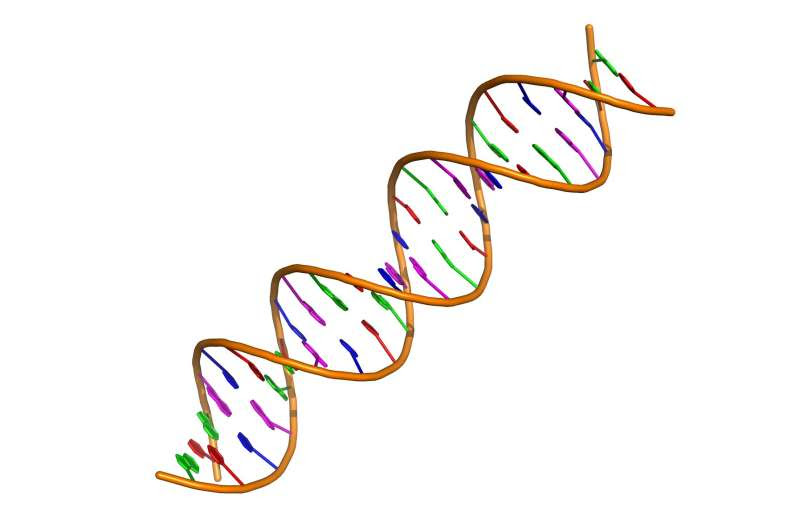by Columbia University’s Mailman School of Public Health

A double-stranded DNA fragment. Credit: Vcpmartin/Wikimedia/ CC BY-SA 4.0
A new study identifies DNA signatures associated with risk for cardiovascular disease, a discovery that could lead to opportunities for clinical intervention years before symptoms manifest. Based on analyses of data from five large heart cohort studies of diverse populations, the findings are published in the journal JAMA Cardiology.
“The science is rapidly advancing in the area of epigenetics—modifications to our DNA that are often environmentally driven and have the potential to serve as early warning sign for disease,” says Ana Navas-Acien, MD, Ph.D., the study’s first author and professor of environmental health sciences at Columbia University Mailman School of Public Health. “In this study, we harness the country’s best clinical data on heart disease from diverse populations to begin to unlock the specific epigenetic changes involved in the complex biology that leads to disease. Ultimately, we hope the research will allow us to identify and prevent disease before the worst damage takes place, although developing appropriate DNA methylation tests is still years away.”
The researchers began their analysis with data from the Strong Heart Study, the largest study of cardiovascular disease in American Indians, conducted in partnership with communities across the Great Plains and the Southwest since 1988. They analyzed blood samples to identify specific locations on DNA where methylation activity was associated with incidents of coronary heart disease, including heart attack and coronary deaths (methylation can change the activity of a DNA segment without changing the genetic sequence).
“The use of high-dimensional statistical methods allowed us to study methylation in hundreds of thousands specific locations in the DNA at the same time,” says Arce Domingo-Relloso, MSc, data scientist and study co-author leading the statistical analyses for this project.
The researchers then took the same approach with four other major heart disease cohorts: Atherosclerosis Risk in Communities (divided into Black and white cohorts due to differences in timing and laboratory methods), Framingham Heart Study, and Women’s Health Initiative. In all, they examined more than 400,000 DNA locations and 1,894 coronary heart disease events.
In the initial analysis of Strong Heart data, they identified 506 epigenetic marks linked to cardiovascular risk. Of these, 33 were also linked to cardiovascular risk in three or more of the other cohorts, although some of these sites were associated with a higher risk of disease in one cohort but with a lower risk of disease in other cohorts. Among the 33 methylation sites are those previously linked to cardiovascular risk and smoking, as well as novel sites that the researchers say are worthy of future investigation. Further analysis of the commonalities between the 33 marks found that many of them are connected with the EGFR gene, which is involved in cell growth and cell survival.
“The overlap of these methylation sites across diverse cohorts supports the idea of interconnected biological pathways for cardiovascular risk,” says Yuling Hong, MD, Ph.D., chief of the epidemiology branch within the Division of Cardiovascular Sciences at the National Heart, Lung, and Blood Institute. “The more we understand about the early risk for cardiovascular disease the better we may be able to prevent illness, particularly in populations such as American Indians with relatively high risk for heart disease.”

Leave a Reply